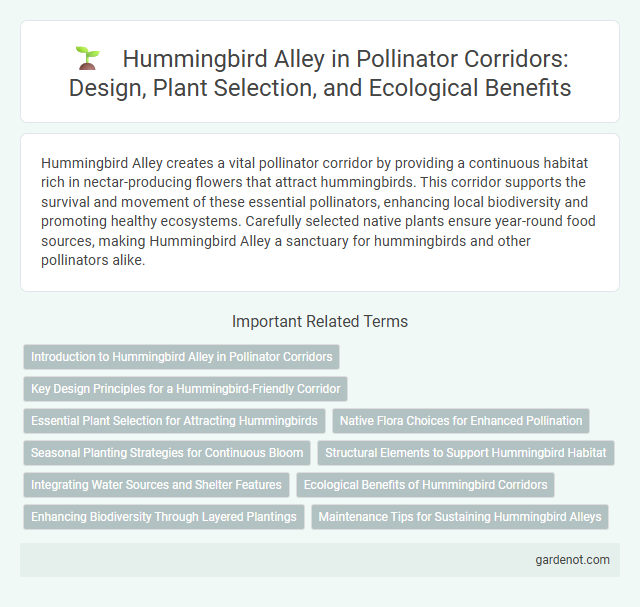Hummingbird Alley creates a vital pollinator corridor by providing a continuous habitat rich in nectar-producing flowers that attract hummingbirds. This corridor supports the survival and movement of these essential pollinators, enhancing local biodiversity and promoting healthy ecosystems. Carefully selected native plants ensure year-round food sources, making Hummingbird Alley a sanctuary for hummingbirds and other pollinators alike.
Introduction to Hummingbird Alley in Pollinator Corridors
Hummingbird Alley serves as a vital segment within Pollinator Corridors, designed to facilitate the migration and habitat connectivity for various hummingbird species across urban and suburban landscapes. This corridor incorporates native flowering plants rich in nectar, providing essential feeding stations that support energy needs during long-distance travel. Strategic placement of Hummingbird Alley enhances biodiversity and promotes sustainable ecosystems by ensuring safe passage for pollinators critical to ecological balance.
Key Design Principles for a Hummingbird-Friendly Corridor
Hummingbird Alley incorporates native flowering plants with staggered bloom times to ensure a continuous nectar supply critical for hummingbird energy needs. The corridor design emphasizes sheltered flight paths using dense shrubs and trees that offer protection from predators and harsh weather. Water sources and perching sites are strategically placed to support resting and hydration, enhancing habitat suitability and promoting hummingbird activity.
Essential Plant Selection for Attracting Hummingbirds
Hummingbird Alley thrives with essential plant selection that includes tubular, nectar-rich flowers such as trumpet vine, bee balm, and salvia, which provide abundant food sources. Native plants like columbine and coral honeysuckle play a crucial role in attracting and sustaining hummingbirds throughout migration seasons. Incorporating diverse flowering periods ensures continuous nectar availability, supporting hummingbird presence from early spring to late fall.
Native Flora Choices for Enhanced Pollination
Hummingbird Alley features native flora such as bee balm (Monarda didyma), cardinal flower (Lobelia cardinalis), and red columbine (Aquilegia canadensis), all of which attract hummingbirds and support their foraging behaviors. These native plants provide high nectar content and blooming patterns that align with hummingbird migration and feeding times, enhancing pollination efficiency. Integrating diverse native species fosters a resilient ecosystem that sustains hummingbird populations and improves overall biodiversity within the pollinator corridor.
Seasonal Planting Strategies for Continuous Bloom
Hummingbird Alley employs seasonal planting strategies to ensure a continuous bloom from early spring through late fall, supporting hummingbird migration and feeding patterns. Native nectar-rich plants like Salvia, Penstemon, and Monarda are staggered to bloom sequentially, providing consistent food sources. Strategic layering of early-blooming bulbs, mid-season perennials, and late-blooming shrubs enhances habitat connectivity and pollinator corridor effectiveness.
Structural Elements to Support Hummingbird Habitat
Hummingbird Alley features specialized structural elements such as vertical trellises, nectar-rich flowering shrubs, and shaded perching stations designed to support hummingbird habitat. Carefully spaced native plants provide continuous blooming sources that ensure a reliable food supply throughout the migration season. The inclusion of natural water features and sheltering foliage enhances protection from predators and harsh weather conditions, optimizing the habitat for hummingbird survival and breeding.
Integrating Water Sources and Shelter Features
Hummingbird Alley incorporates strategically placed water sources such as shallow birdbaths and misting stations to attract and sustain hummingbird populations throughout the corridor. Shelter features including dense shrubs, native flowering plants, and vertical structures provide essential nesting sites and protection from predators and weather extremes. Integrating these elements supports hummingbird foraging and breeding behaviors, enhancing the overall effectiveness of the pollinator corridor.
Ecological Benefits of Hummingbird Corridors
Hummingbird corridors like Hummingbird Alley enhance biodiversity by providing continuous habitats and food sources essential for hummingbird migration and reproduction. These corridors support pollination of native plants, boosting ecosystem resilience and agricultural productivity. Establishing such corridors also helps mitigate habitat fragmentation, ensuring stable hummingbird populations and promoting overall ecological balance.
Enhancing Biodiversity Through Layered Plantings
Hummingbird Alley boosts biodiversity by incorporating layered plantings that provide diverse nectar sources and nesting habitats essential for hummingbirds. Multi-tiered vegetation structures support various pollinators, creating a dynamic ecosystem that strengthens pollination networks. This strategic planting approach enhances habitat complexity and sustains pollinator populations year-round.
Maintenance Tips for Sustaining Hummingbird Alleys
Regular pruning of native flowering plants supports continuous nectar availability in hummingbird alleys. Incorporating seasonal watering schedules maintains optimal soil moisture, preventing plant stress and ensuring vibrant blooms. Monitoring for pests and diseases allows early intervention, preserving plant health and sustaining a reliable food source for hummingbirds.
Hummingbird alley Infographic

 gardenot.com
gardenot.com